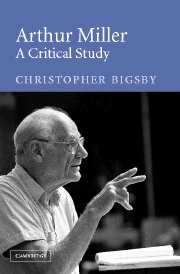Book contents
- Frontmatter
- Contents
- Acknowledgements
- Note on the text
- Introduction
- 1 The Michigan plays
- 2 The Golden Years, The Half-Bridge, Boro Hall Nocturne
- 3 The radio plays
- 4 The Man Who Had All the Luck
- 5 Focus
- 6 All My Sons
- 7 Death of a Salesman
- 8 Arthur Miller: time-traveller
- 9 An Enemy of the People
- 10 The Crucible
- 11 A Memory of Two Mondays
- 12 A View from the Bridge
- 13 Tragedy
- 14 The Misfits
- 15 After the Fall
- 16 Incident at Vichy
- 17 The Price
- 18 The Creation of the World and Other Business
- 19 The Archbishop's Ceiling
- 20 Playing for Time
- 21 The shearing point
- 22 The American Clock
- 23 The one-act plays: Two-Way Mirror, and Danger: Memory!
- 24 The Ride Down Mount Morgan
- 25 The Last Yankee
- 26 Broken Glass
- 27 Mr Peters' Connections
- 28 Resurrection Blues
- 29 Finishing the Picture
- 30 Fiction
- 31 Arthur Miller as a Jewish writer
- Notes
- Index
19 - The Archbishop's Ceiling
Published online by Cambridge University Press: 16 November 2009
- Frontmatter
- Contents
- Acknowledgements
- Note on the text
- Introduction
- 1 The Michigan plays
- 2 The Golden Years, The Half-Bridge, Boro Hall Nocturne
- 3 The radio plays
- 4 The Man Who Had All the Luck
- 5 Focus
- 6 All My Sons
- 7 Death of a Salesman
- 8 Arthur Miller: time-traveller
- 9 An Enemy of the People
- 10 The Crucible
- 11 A Memory of Two Mondays
- 12 A View from the Bridge
- 13 Tragedy
- 14 The Misfits
- 15 After the Fall
- 16 Incident at Vichy
- 17 The Price
- 18 The Creation of the World and Other Business
- 19 The Archbishop's Ceiling
- 20 Playing for Time
- 21 The shearing point
- 22 The American Clock
- 23 The one-act plays: Two-Way Mirror, and Danger: Memory!
- 24 The Ride Down Mount Morgan
- 25 The Last Yankee
- 26 Broken Glass
- 27 Mr Peters' Connections
- 28 Resurrection Blues
- 29 Finishing the Picture
- 30 Fiction
- 31 Arthur Miller as a Jewish writer
- Notes
- Index
Summary
When the Berlin Wall came down, in 1989, crowds invaded the headquarters of the secret police, the Stasi, and threw files down stairwells and out into the street, a blizzard of reports by informants. Down floated words – true, false – that had reshaped lives, the language of a paranoid state like some vast, encompassing novel. This, rather than Party headquarters or the site of an ersatz parliament, was the centre of a power that had not merely held the people in thrall but determined the nature of reality, the form of human relationships, the context within which citizens lived their lives.
This place was, in a sense, a repository of truths, half-truths and lies which defined the limits of possibility for individuals and for the state. Later, when the euphoria had subsided, those same documents were gathered up, the mosaic of shredded papers glued together, to discover the extent of the betrayals embodied in an archive of calumny. The result was profoundly disturbing. Friend had spied on friend, husband on wife; dissidents were exposed as agents, foreign academics as accomplices. For nearly forty-five years East Germany, and beyond that, plainly, the other countries of the Eastern bloc, had been turned into a theatre in which people masqueraded as what they were not, played out roles assigned to them, spoke dialogue handed to them by those who thereby became the authors of their lives.
- Type
- Chapter
- Information
- Arthur MillerA Critical Study, pp. 295 - 311Publisher: Cambridge University PressPrint publication year: 2004



